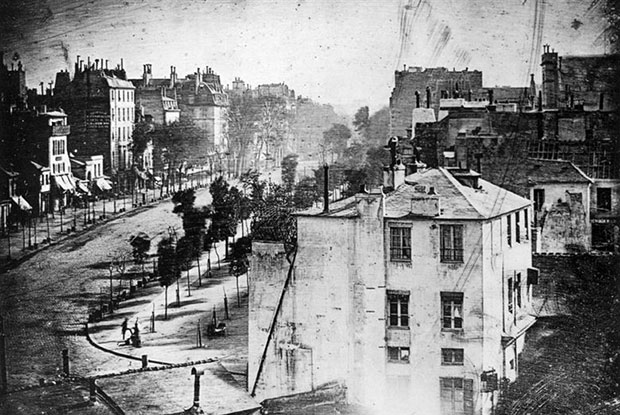
Photos that changed the world #8 Louis-Jacques Mandé Daguerre's Boulevard du Temple, Paris
On the anniversary of his birth, a look at how Daguerre took the first picture to feature a human
To learn just how dramatically photography democratized the visual arts, you need only need to take a look at this, the first photograph to capture a human form. The picture, taken by Louis-Jacques-Mandé Daguerre, who was born today, 18 November, in 1787, did not feature any latter-day statesman or star. Indeed, the identities of the two subjects caught in his image, a shoeshine boy and his patron, are unknown and are unlikely to have come from the upper levels of French society.
As Ian Jeffrey, the academic and author of our newly updated edition of The Photography Book, explains “The Boulevard du Temple was a haunt of Parisian lowlife in 1838, when this very early photograph was taken. Along it were many theatres showing horror plays, which resulted in its nickname, Boulevard du Crime.”
Daguerre was familiar with the street; he had worked there as a stage designer at its Theatre Ambigu-Comique. Both a commercial artist and innovative technician, Daguerre invented the diorama, or three-dimensional model scenery commonly employed as a stage device, as well as the daguerreotype, an early photograph process whereby mercury vapour is used to develop an exposure of silver iodide on a copper plate. The daguerreotype was not only the first publicly announced method of photography, when Daguerre described it in the 27 September 1835 edition of the Parisian magazine, Journal des artistes; it was also a relatively simple process, and so became the first method to be widely adopted by fellow practitioners.
However, while, kings and queens would later pose for daguerreotypes, the form still arose, as Jeffrey writes, “out of such low haunts, and amongst people who scarcely mattered. The quacks and entertainers who peopled the boulevard are not even visible in this picture, apart from a blurred shoe-shiner and his static patron, both of whom must have been on the spot for the several minutes required for an exposure.”
Nevertheless, the two figures and their gritty street found global fame. “This photograph was soon known throughout the world through descriptions in the press marveling at the kind of details on show: cracked plaster and distant commercial inscriptions.”
Daguerre's invention offered a near-instant, realistic rendering of the world, cracks and all, and even the most ignoble scene could match the verisimilitude of the Great Masters.
The Boulevard du Temple is just one of over 500 images featured in our newly published The Photography Book. You can read previous entries in our Photos That Changed The World series on Weegee, Ansel Adams, Richard Avedon and Eadweard Muybridge; and if you like what you've read, you'll find a whole lot more in The Photography Book here. Finally, here's an interview with its author, Ian Jeffrey.